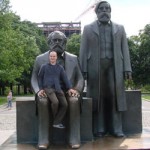Title
With the ink on our Artist Diplomas barely dry, the Calder Quartet headed across the Atlantic to Berlin in May to study and perform as part of an exchange between The Juilliard School and the Hochschule für Musik “Hanns Eisler.” Our red-eye flight touched down at Berlin Tegel Airport and a few hours later we were at the Hochschule, bleary eyed from jet lag and graduation revelry, hunkering down for a three-hour coaching on Haydn. It was a week before the official exchange activities began, and the first of three marathon sessions with Hanns Eisler faculty member and string-quartet guru Eberhard Feltz that would fundamentally change the way we heard music.
Body
We stood and performed 10-second sustained bow strokes for our colleagues, counted the numbers of measures in each phrase of an entire movement, determined which cadences should sound “open” and which should sound “closed,” quoted Kant, and tried to sharpen our musical sense of humor. All 10 hours of study were conducted in German. I remember the Juilliard String Quartet telling us to articulate the ends of notes in the works of German-speaking composers, echoing German diction. Ten hours of instruction in German focusing on German composers really brought that message home.
Our musical horizons widened, we had a few days off to explore Berlin before our Juilliard colleagues joined us and the formal exchange activities began. Berlin is a city coming to terms with what it left behind and intent on what lies before it. Destroyed in the Second World War and divided against itself during the cold war, the city was described thus by Hans-Juergen Heimsoeth, Germany’s consul general in New York: “Since the wall came down 16 years ago, Berlin is reinventing itself as the capital of a united Germany.” Its European heritage, reflected in the storied classical-music tradition that drew us there, and a vitality stemming from a post-cold-war rebirth, which I witnessed in an exploding modern art scene, captivated me.
When I wasn’t working on my 10-second bows, I took in a mixed landscape—some historic structures intact but most in ruins, and modern architectural gems juxtaposed against blocks of oppressively efficient communist engineering. World War II resulted in “so many open spaces in the center of the town,” Heimsoeth explained, that “these are now being put into use and the construction contributes to the reinvention of Berlin.” Walking around in town one day I stumbled upon the bombed-out and breathtaking Kaiser Wilhelm Memorial Church (a church from the late 1800s partially destroyed in the war and left as a modern ruin), and watched an open rehearsal in the architecturally and acoustically renowned home of the Berlin Philharmonic, Berliner Philharmonie in Berlin-Tiergarten. It was built in the shadow of the Berlin Wall in the 1960s, and I loved how it placed the orchestra in the midst of the audience.
We were joined a few days later by Juilliard faculty member and exchange organizer Lewis Kaplan and the rest of our Juilliard colleagues. Back at Hanns Eisler, I began to notice some differences between our respective cities and institutions. Hanns Eisler is in formerly communist East Germany and communist-era art still decorates the façade. I—along with my Calder Quartet colleagues Benjamin Jacobson, Jonathan Moerschel, and Eric Byers, and my fellow Juilliard students Sean Rice, Brandon Ridenour, Joseph Rodriguez, and Ran Dank—were staying near the Hochschule, and daily walked by an oversized statue of Marx and Engel in the nearby Alexanderplatz on the way to school. The state generously supports the arts and, as a result, all Hanns Eisler students attend virtually for free. At first, it seemed perfect: how could any conservatory student not appreciate the opportunity to practice and study with few financial concerns? But as Claudia von Arnim, a key organizer of the exchange and our second mother in Berlin, explained, “The readiness to sponsor classical music also needs to be improved in a society that has been used to public subsidies, which are vanishing nowadays.” I started to notice that at every event there were a few women who were intelligent, sophisticated, and knew their classical music cold. They were Hanns Eisler’s answer to the dilemma outlined by von Arnim. Inspired by the American educational system, Hanns Eisler has created a 10-member Freundeskreis, or Society of Friends and Supporters of Hanns Eisler (of which von Arnim is a member), which supports the school by providing ideas, networking, and opportunities for students above and beyond what the state offers.
Tanja Dorn, a vice president of IMG Artists and an early organizer of the exchange, said that an exchange like this shows that “musical diplomacy is politics at the highest level.” As I spent the week rushing between rehearsals with my Hanns Eisler colleagues in preparation for the Concert of Friendship, studying with faculty from Juilliard and Hanns Eisler, and performing with our Juilliard colleagues in venues all over Berlin, nothing was further from my mind. Backstage waiting for my stage call at the Concert of Friendship, I finally had a moment of reflection. I took a minute off from practicing my limited French with a Hanns Eisler student to watch the Calder Quartet’s cellist, Eric Byers, jamming on a Rossini bass line with a German student bass player and realized that all of the week’s musical work had resulted in relationships that would endure. At the end of the evening, the entire cast of the marathon concert took the stage for two bows. Standing shoulder-to-shoulder, the Hanns Eisler and Juilliard students stretched all the way across the stage. Basking in the warm applause of a full house, I was beginning to realize that we had, in some small way, brought our two countries closer together.





